To develop full, proportional shoulders, you have to make rear delt exercises a priority.
Why?
Because most people spend plenty of time training their front and side delts with presses and side raises, but much less time building the back of their shoulders with rows, reverse flys, and the like.
Over time, this causes a “front-heavy” look that throws your upper body aesthetics out of whack.
What’s more, it can also increase your risk of shoulder injury, hinder your athletic performance, and cause your shoulders to hunch.
In this article, you’ll learn the best rear delt exercises for building mass and strength. You’ll also discover why they’re effective and discover tips for making your rear delt workouts as productive as possible.
Key Takeaways
- The rear delts are the part of your shoulder muscles that cover the back of your shoulder joints on your upper back.
- The benefits of doing rear delt exercises are that they help you build proportional shoulders, prevent injuries, perform better on other key exercises, and improve your posture.
- The best rear delt exercises are the barbell and dumbbell row, regular and neutral-grip pull-up, neutral-grip pulldown, cable row, rear delt row, rear lateral raise, machine reverse fly, and face pull.
- Rear delt workouts should include a mix of compound exercises like rows and pull-ups, and isolation movements like rear lateral raises and face pulls, to maximize muscle growth.
- To see the best results from your posterior deltoid training, aim for 10-to-20 weekly sets of rear delt exercises, split between back and shoulder workouts.
Table of Contents
+
What Are the Rear Delts?

The deltoids—or “delts”—are the muscles that cover your shoulder joints and help move your upper arms forward, upward, and backward.
Each deltoid has three sections or “heads:” the anterior deltoid, the lateral deltoid, and the posterior deltoid.
Here’s how they look on your body:
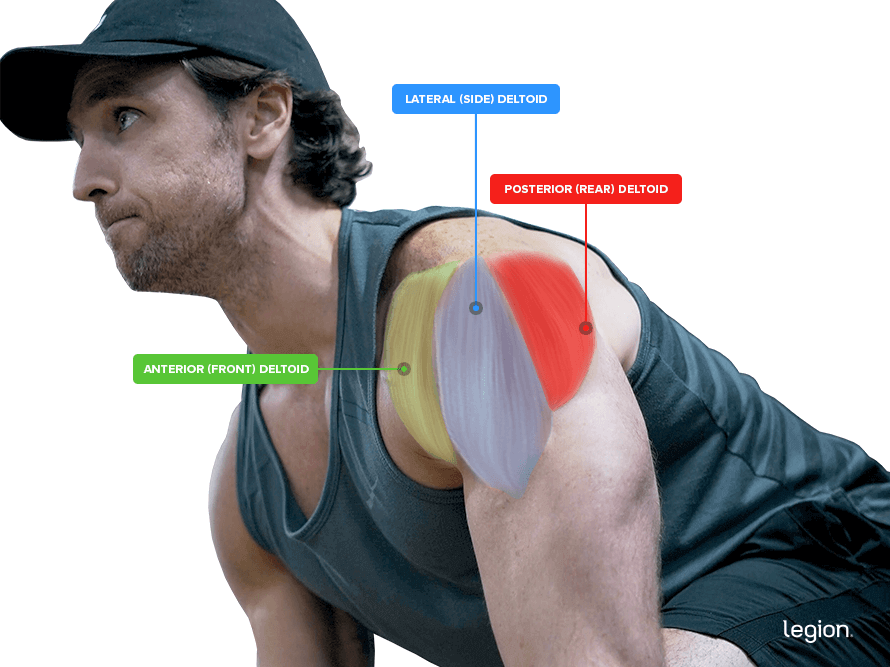
The posterior deltoids are better known among weightlifters as the “rear delts” because they’re located behind your shoulder joints on your upper back.
The Benefits of Doing Rear Delts Exercises
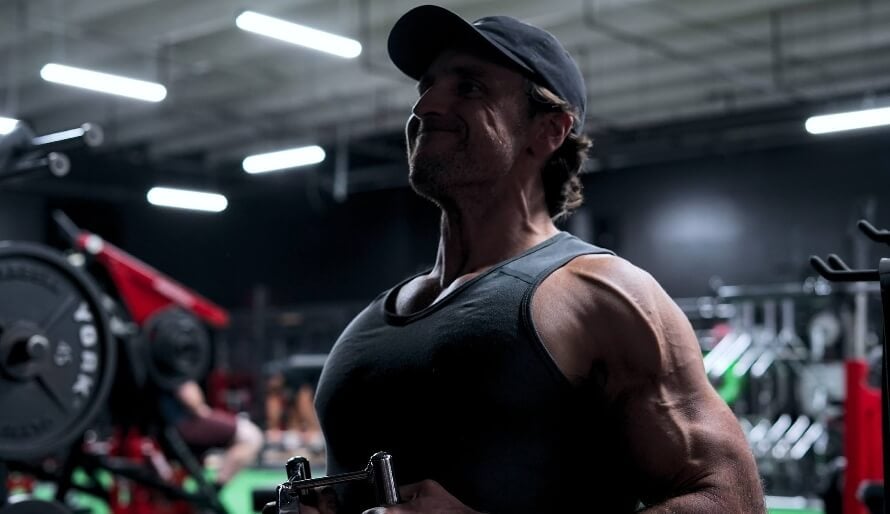
Training your rear delts does far more than round out your shoulders. It helps you build a balanced, proportional upper body, reduces your risk of injury, improves your performance on key lifts like the squat and bench press, and even enhances your posture.
Here’s a closer look at why rear delt exercises should be a priority in your workout routine.
Proportional Muscle Growth
The rear delts are smaller and more stubborn than the other heads of the deltoids, which means they often need a bit of extra attention in the form of good rear delt exercises if you want them to grow at the same rate as your front and side delts.
Increased Shoulder Health
Many weightlifters spend more time training their front and side delts with pushing exercises than they do training their rear delts with pulling exercises.
Over time this can cause a strength and size imbalance between your rear delts and your front and side delts, which may increase your risk of injury.
Enhanced Athletic Performance
The rear delts work alongside the other upper back muscles to help you stay upright in the squat, keep your back flat in the deadlift, and create a solid base in the bench press.
Strengthening them helps you lift heavier weights on these exercises, which means you build more full-body muscle and strength over time.
Improved Posture
Many people with poor posture have weak rear delts. Strengthening them with effective rear delt exercises helps you to pull your shoulders back and prevents excessive upper back rounding.
The 10 Best Rear Delt Exercises for Shoulder Mass & Strength

Below are the 10 best rear delt exercises for mass and strength. Make these the focus of your rear delt workouts and you’ll see size gains in no time.
1. Barbell Row
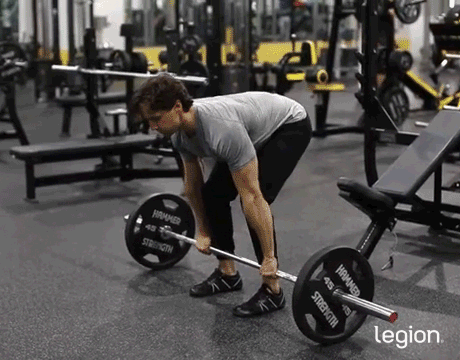
Why: The barbell row is the best rear delt exercise because it allows you to train your entire upper back through a full range of motion with heavy weights, so it’s ideal for gaining size and strength. It’s no surprise that those with the biggest rear delts make the barbell row a cornerstone of the rear delt workouts.
How to:
- Stand with your feet shoulder-width apart under a loaded barbell, toes slightly pointed outward.
- Bend over and grip the bar just wider than shoulder-width, palms facing you.
- Straighten your back and lift your hips until your back is parallel to the floor.
- Drive through your legs and use the momentum to pull the barbell toward your upper body, touching it between your lower chest and belly button.
- Reverse the movement and return to the starting position.
Expert Tip: If your grip fails before your back muscles, try using lifting straps. These secure your hands to the barbell, ensuring your back muscles—not your grip—are the limiting factor.
READ MORE: The 12 Best Barbell Row Variations You Can Do
2. One-Arm Dumbbell Row

Why: The one-arm dumbbell row is a highly effective rear delt exercises that trains each side of your body independently. This helps you find and fix muscle imbalances that can hamper your performance and make your physique look lopsided.
How to:
- Hold a dumbbell in your right hand.
- Place your left knee and hand on a bench, with your right foot planted on the floor 1-to-2 feet away, and let your right arm hang straight down.
- Keep your back straight and pull the dumbbell toward your torso, then lower it back to the starting position.
- Complete the desired number of reps, then switch to your left arm and repeat.
Expert Tip: The one-arm dumbbell row gets harder as you lift the weight higher, making it tough to finish reps even if the start feels easy. This can cause you to stop your set before fully stimulating your back and rear delts.
To fix this, use a little momentum to help lift the weight through the full range of motion. This ensures you complete more full reps and build more muscle and strength over time.
READ MORE: How to Do the Bent-Over Dumbbell Row
3. Pull-up

Why: Many gymgoers don’t realise it, but pull-ups work your rear delts to a high-degree. They’re also a very scalable exercise, making them ideal for applying progressive overload. Beginners can start with assisted pull-ups, then progress to the bodyweight version, and eventually tackle weighted pull-ups as they get stronger.
How to:
- Grab a pull-up bar slightly wider than shoulder-width apart with your palms facing away from you.
- Lift your feet so that you’re hanging with your arms straight.
- Pull your body up until your chin is above the bar.
- Reverse the movement and return to the starting position.
Expert Tip: Pulling yourself up with enough force to “smash” your chest into the bar helps you attack each rep with the intensity you need to get your chin over the bar.
READ MORE: How to Do Your First Pull-up with Proper Form
4. Close-Grip Lat Pulldown

Why: Research shows that the close-grip lat pulldown trains the rear delt slightly better than other pulldown variations, which is why it’s the variation I recommend you include in your rear delt workouts. That said, if you can’t or don’t want to do this variation, the regular-grip or pronated-grip versions are viable alternatives.
How to:
- Adjust the thigh pad to lock your lower body in place.
- Stand up, grab the handle, and sit down while keeping your grip and arms straight. Let your weight pull the handle down, then position your thighs under the pads and plant your feet.
- Pull the handle toward your chest.
- Once the handle is under your chin, return it to the starting position.
Expert Tip: To ensure your elbows are driving downward and you’re engaging your back muscles and rear delts effectively, imagine slamming your elbows into the floor.
READ MORE: Close-Grip Lat Pulldown: Form, Benefits & Variations
5. Neutral-Grip Pull-up

Why: The neutral-grip pull-up is another excellent bodyweight rear delt exercise. Its grip mimics the close-grip lat pulldown, which, as we’ve seen, may be slightly better for targeting the rear delts than other grip orientations.
How to:
- Grab a neutral-grip pull-up bar with your palms facing each other.
- Lift your feet so that you’re hanging with your arms straight.
- Pull your body up until your chin is above the bar.
- Reverse the movement and return to the starting position.
Expert Tip: As you tire, resist the urge to swing your legs to generate momentum. Instead, brace your core, arch your back, and squeeze your glutes. Doing so makes the movement more efficient and ensures the target muscles are doing the work.
6. Seated Cable Row
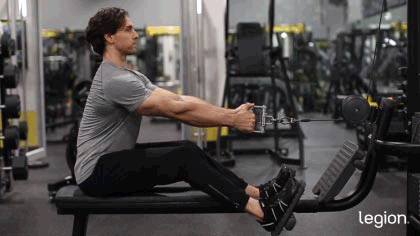
Why: Cable rear delt exercises, like the seated cable row, keep constant tension on your muscles throughout each rep, which poses a different challenge than free weights. This adds variety and intensity to your rear delt workouts, which likely aids growth.
How to:
- Sit down and place your feet on the foot-rest while maintaining slightly bent knees.
- Lean forward and grab the handle, then lean back with your arms stretched in front of you.
- Straighten your back and pull the cable toward your stomach.
- Once your hands touch your torso, reverse the movement and return to the starting position.
Expert Tip: To train your rear delts through the largest range of motion possible, let the cable pull your shoulder blade apart and round your upper back at the bottom of each rep. Then, as you pull, drive your shoulder blades together and lean slightly back as you row the handle toward your torso.
READ MORE: How to Do the Seated Cable Row: Muscles Worked, Form, and Alternatives
7. Barbell Rear Delt Row
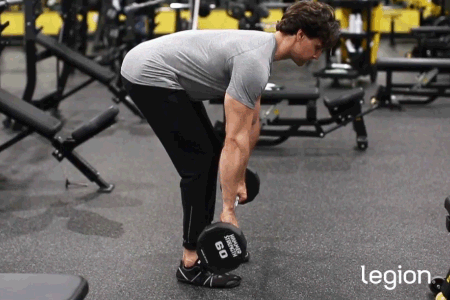
Why: The barbell rear delt row is similar to the barbell row except that you pull the weight to your mid chest instead of your stomach. This reduces the amount your lats contribute to the exercise and makes it more taxing on your rear delts.
How to:
- Stand with your feet shoulder-width apart under a loaded barbell, toes slightly pointed outward.
- Bend over and grip the bar just wider than shoulder-width, palms facing you.
- Straighten your back and lift your hips until your back is parallel to the floor.
- Pull the barbell to your mid chest, making sure to flair your elbows at about a 60-degree angle relative to your body.
- Reverse the movement and return to the starting position.
Expert Tip: With the regular barbell row, you aim to keep your elbows tucked around 8-to-10 inches from your sides, but with the rear delt row, allow your elbows to flare further, almost until they are perpendicular to your torso.
READ MORE: How to Do the Rear Delt Row: Benefits, Form, & Alternatives
8. Dumbbell Rear Lateral Raise
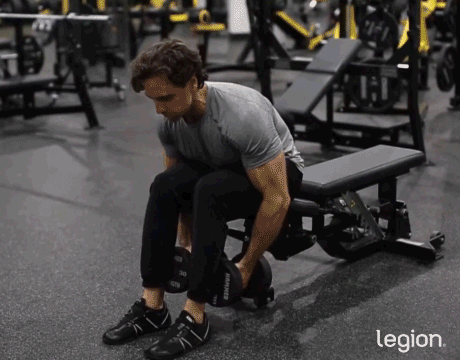
Why: The dumbbell rear lateral raise is a top-tier dumbbell rear delt exercise because it trains your rear delts’ primary function: horizontal shoulder abduction (moving your arms from out in front of you out to your sides). That’s why all the most effective posterior deltoid training includes the dumbbell rear lateral raise.
How to:
- Whether standing or seated, bend at the hips so that your upper body is as close to parallel to the floor as possible.
- Hold a dumbbell in each hand, and while keeping your back flat and a slight bend in your elbows,, lift the dumbbells out to the side until your upper arm is parallel to the floor.
- Reverse the movement and return to the starting position.
Expert Tip: Some people find it challenging to balance when they perform the rear lateral raise standing. If that’s the case for you, perform it sitting on the edge of a bench.
READ MORE: How to Do the Dumbbell Rear Lateral Raise: Form, Benefits, & Variations
9. Machine Reverse Fly
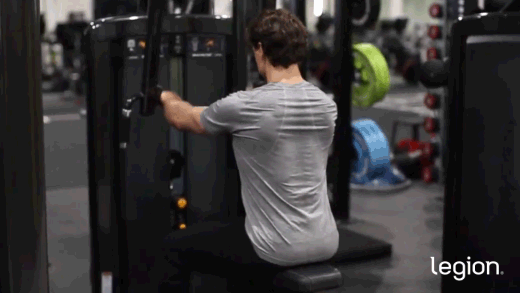
Why: Research shows the machine reverse fly activates the rear delts more than exercises like the seated cable row and lat pulldown. This doesn’t necessarily mean it’s more effective than these exercises for developing your rear delts (especially since you can use far less weight with the machine reverse fly), but it’s a solid indication that it’s worth including in your rear delt workouts.
How to:
- Sit facing the machine with your feet firmly planted and the handles at shoulder height.
- Grab the handles with your palms facing down and press your chest against the pad.
- With a slight bend in your elbows, pull the handles back in an arc until your arms are straight out to the sides or slightly behind your body.
- Reverse the movement and return to the starting position.
Expert Tip: Many people shorten the range of motion during the machine reverse fly. To avoid this, let your hands come as close together as possible at the bottom of each rep and drive your elbows slightly past your torso at the top.
READ MORE: Machine Reverse Fly: Alternatives, Muscles Worked & Form
10. Face Pull
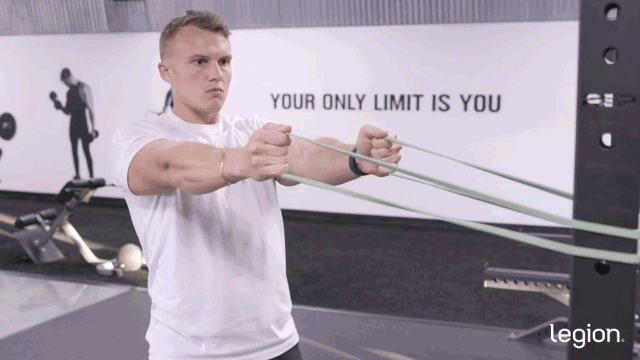
Why: The face pull trains all the muscles responsible for pulling horizontally toward your face (including the rear delts) and strengthens the shoulder muscles that rotate your arm upward. These benefits are unique to the face pull and may help you build stronger, more robust shoulders.
How to:
- Set the pulley on a cable machine to eye level and attach a rope handle.
- Grab one end of the rope in each hand and step back until the cable is taut and your arms are stretched out in front of you.
- Stand upright with a slight bend in your knees and your feet shoulder-width apart.
- Keeping your elbows high, pull the rope toward your eyes, spreading the rope apart until your hands are above your shoulders.
- Reverse the movement and return to the starting position.
Expert Tip: You don’t need to use heavy weights to make face pulls effective. In fact, lifting too much often makes them less effective because it tempts you to rely on momentum instead of good form. Stick to the 8-to-10 or 10-to-12 rep range to build muscle and strength while keeping your technique clean and controlled.
READ MORE: How to Do the Face Pull: Benefits, Form, & Alternatives
5 Rear Delt Training Tips for More Productive Workouts

Use these five tips to ensure you get maximum results from your rear delt workouts.
1. Do the right rear delt-focused exercises.
The “secret” to building the biggest rear delts possible is to get as strong as you can on compound exercises that train your rear delts. And that means dedicating most of your training time to pull-up, pulldown, and row variations.
That said, if you want to maximize rear delt growth, research shows that it’s worth doing isolation exercises that emphasize your rear delts, too.
A solid approach is to spend 75% of your training time on compound movements that train your rear delts, and the remaining 25% on rear delt isolation exercises.
2. Use the right mix of volume and intensity.
You can do all the best rear delt exercises for mass, but they won’t have the desired effects if you don’t also manage volume and intensity correctly. Here’s what you need to know:
- Train your rear delts with 10-to-20 weekly sets: If you’ve been training for less than a year, doing 10-to-15 weekly sets is sufficient. If you’ve trained longer than a year, doing 15-to-20 weekly sets split over 2-to-3 workouts will yield better results.
- Use 85-to-90% of your one-rep max for most sets: Do ~75% of your rear delt exercises in the 4-to-6 rep range (85-to-90% of your one-rep max) and the remaining ~25% with slightly lighter weights (7-to-12 rep range).
- End all sets 1-to-3 reps shy of failure: To maximize your results, take most sets of rear deltoid exercises close to failure. Ask yourself at the end of each set, “If I had to, how many more reps could I have gotten with good form?” If the answer is more than two, increase the weight or reps to make your next set more challenging.
3. Once you hit the top of your rep range for a set, move up in weight.
If you stop getting stronger, your rear delts will eventually stop getting bigger (this applies to every major muscle group in the body).
The simplest way to get strong and build muscle is to use double progression. For example, if your rear delt workout calls for 4-to-6 reps of the barbell row and you get 6 reps for a set, add 10 pounds to your next set.
If you manage 3 or fewer reps with the new weight, reduce the weight by 5 pounds to ensure you stay in the 4-to-6 rep range.
Follow this pattern of trying to add reps or weight to every rear delt exercise in every workout.
READ MORE: Double Progression Guide: How to Use Double Progression to Gain Muscle and Strength
4. Prioritize rear delt exercises.
Studies show that you make the fastest progress on muscle groups that you train at the beginning of your workouts.
So, to maximize rear delt development, shift exercises that emphasize the rear delts to the beginning of your back, pull, or upper-body workouts.
5. Take the right supplements.
The best supplements for optimizing your rear delt workouts are:
- Protein powder: Protein powder, such as whey or casein, provides your body with the nutrients needed to build muscle tissue and recover from workouts.
- Creatine: Creatine supplements, such as creatine monohydrate powder and gummies, boost muscle and strength gain, improve anaerobic endurance, and reduce muscle damage and soreness from your workouts.
- Pre-workout: A high-quality pre-workout enhances energy, mood, and focus, increases strength and endurance, and reduces fatigue.
FAQ #1: What is the best rear delt exercise?
There’s no such thing as the “best” exercise for rear delts. In fact, research shows that the best way to maximize the growth of any muscle is to train it with a variety of exercises that challenge it in different ways, rather than using just one.
So, to build the biggest rear delts possible, include several of the exercises in this article in your routine each week.
FAQ #2: What’s the best rear delt workout?
The rear delts are a small part of the shoulder muscles, so dedicating an entire workout to them isn’t practical. A better approach is to focus on exercises that emphasize the rear delts as part of a back or pull day workout.
Here’s how this might look:
- Barbell Row: 3 sets | 4-to-6 reps | 3-to-5 min rest
- Close-Grip Lat Pulldown: 3 sets | 4-to-6 reps | 3-to-5 min rest
- Seated Cable Row: 3 sets | 6-to-8 reps | 3-to-5 min rest
- Machine Reverse Fly: 3 sets | 6-to-8 reps | 3-to-5 min rest
Do this “rear delt workout” once weekly as part of a well-designed training program and, provided your diet and recovery is on point, you should see significant gains in rear delt size within 3-to-6 months.
FAQ #3: How do I get big rear delts?
Getting big rear delts mostly comes down to performing the best rear delt exercises (see the list above), eating enough calories and protein, and staying patient.
Most guides to the best rear deltoid exercises gloss over this last point, but it’s paramount. To make noticeable changes to your rear delts’ size, it’ll take several months of consistent, targeted training, and to get standout rear delts, it takes years of effort.
FAQ #4: How should you organize posterior deltoid training?
To develop your rear deltoids, dedicate ~75% of your posterior deltoid training to compound exercises that train the backs of your shoulders, including pull-up, pulldown, and row variations.
Then, to maximize rear delt size, spend the remaining ~25% of your training time doing rear delt isolation exercises, such as the rear delt fly, rear delt row, and face pull.
Scientific References +
- Page, P. (2011). SHOULDER MUSCLE IMBALANCE AND SUBACROMIAL IMPINGEMENT SYNDROME IN OVERHEAD ATHLETES. International Journal of Sports Physical Therapy, 6(1), 51. /pmc/articles/PMC3105366/
- Fenwick, Chad M J, et al. “Comparison of Different Rowing Exercises: Trunk Muscle Activation and Lumbar Spine Motion, Load, and Stiffness.” Journal of Strength and Conditioning Research, vol. 23, no. 2, Mar. 2009, pp. 350–358, https://doi.org/10.1519/jsc.0b013e3181942019.
- Ronai, Peter. “The Barbell Row Exercise.” ACSMʼs Health & Fitness Journal, vol. 21, no. 2, 2017, pp. 25–28, https://doi.org/10.1249/fit.0000000000000278.
- Signorile, Joseph F., et al. “A Comparative Electromyographical Investigation of Muscle Utilization Patterns Using Various Hand Positions during the Lat Pull-Down.” Journal of Strength and Conditioning Research, vol. 16, no. 4, 1 Nov. 2002, pp. 539–546, pubmed.ncbi.nlm.nih.gov/12423182/.
- HANDA, TOHRU, et al. “COMPARATIVE ELECTROMYOGRAPHICAL INVESTIGATION of the BICEPS BRACHII, LATISSIMUS DORSI, and TRAPEZIUS MUSCLES during FIVE PULL EXERCISES.” Japanese Journal of Physical Fitness and Sports Medicine, vol. 54, no. 2, 2005, pp. 159–168, https://doi.org/10.7600/jspfsm.54.159.
- De Vasconcelos Costa, B. D., Kassiano, W., Nunes, J. P., Kunevaliki, G., Castro-E-Souza, P., Rodacki, A., Cyrino, L. T., Cyrino, E. S., & Fortes, L. D. S. (2021). Does Performing Different Resistance Exercises for the Same Muscle Group Induce Non-homogeneous Hypertrophy? International Journal of Sports Medicine, 42(9), 803–811. https://doi.org/10.1055/A-1308-3674
- Rodrigo Franke, Cíntia Ehlers Botton, Ronei S Pinto, & Rodrigo Rodrigues. (n.d.). (PDF) Analysis of anterior, middle and posterior deltoid activation during single and multijoint exercises. Retrieved January 28, 2022, from https://www.researchgate.net/publication/263292517_Analysis_of_anterior_middle_and_posterior_deltoid_activation_during_single_and_multijoint_exercises
- Romano, N., Vilaça-Alves, J., Fernandes, H. M., Saavedra, F., Paz, G., Miranda, H., Simão, R., Novaes, J., & Reis, V. (2013). Effects of Resistance Exercise Order on the Number of Repetitions Performed to Failure and Perceived Exertion in Untrained Young Males. Journal of Human Kinetics, 39(1), 177. https://doi.org/10.2478/HUKIN-2013-0080
- Roberto Simão, Juliano Spineti, Belmiro F. de Salles, Liliam F. Oliveira, Thiago Matta, Fabricio Miranda, Humberto Miranda, & Pablo B. Costa. (n.d.). INFLUENCE OF EXERCISE ORDER ON MAXIMUM STRENGTH AND MUSCLE THICKNESS IN UNTRAINED MEN, JSSM-2010, Vol.9, Issue 1, 1 - 7. Retrieved January 28, 2022, from https://www.jssm.org/vol9/n1/1/v9n1-1text.php
- Stokes, Tanner, et al. “Recent Perspectives Regarding the Role of Dietary Protein for the Promotion of Muscle Hypertrophy with Resistance Exercise Training.” Nutrients, vol. 10, no. 2, 7 Feb. 2018, p. 180, www.mdpi.com/2072-6643/10/2/180/pdf.
- Snarr, Ronald L., et al. “Electromyographical Comparison of a Traditional, Suspension Device, and Towel Pull-Up.” Journal of Human Kinetics, vol. 58, 1 Aug. 2017, pp. 5–13, www.ncbi.nlm.nih.gov/pmc/articles/PMC5548150/, https://doi.org/10.1515/hukin-2017-0068.










